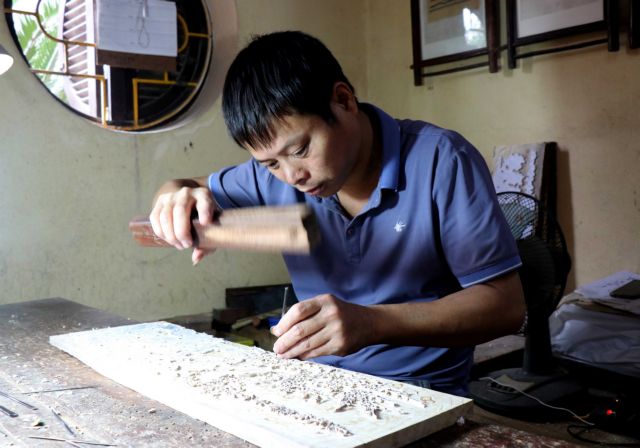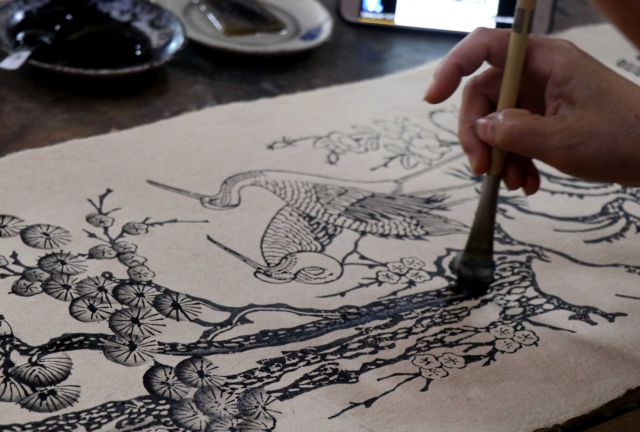
An artisan is working on his Đông Hồ painting. — VNA/VNS Photo Đinh Văn Nhiều
BẮC NINH — The northern province of Bắc Ninh has completed a dossier seeking UNESCO’s inclusion of the making of Đông Hồ folk paintings on the list of intangible cultural heritage in need of urgent protection.
The provincial People’s Committee has proposed the Ministry of Culture, Sports and Tourism (MCST) to send the dossier to the Prime Minister for consideration and submission to UNESCO, the ministry said on Thursday.
Director of the Việt Nam National Institute of Culture and Arts, Bùi Hoàng Sơn said the ministry held an online meeting to complete the dossier before it was submitted to UNESCO by March 31.
For two years after getting agreement from the ministry in 2018, Bắc Ninh Province had built the dossier titled "Đông Hồ Folk Painting Handicraft" to submit to UNESCO’s Education, Science and Culture Organisation.
The province's People's Committee directed the provincial Department of Culture, Sports and Tourism in collaboration with the Việt Nam National Institute of Culture and Arts to develop the dossier in accordance with regulations and guidelines of the 2003 UNESCO Convention to put the handicraft on the list of intangible cultural heritage in need of urgent protection.
After collecting opinions from scientific researchers and completing adjustments and corrections, the dossier has been completed, meeting regulative requirements and submitted to the Standing Committee of the National Cultural Heritage Council.
According to researchers, the painting is a product of woodblock printing genre created by residents in Đông Hồ Village of Song Hồ Commune, Bắc Ninh’s Thuận Thành District.

An artisan is working on a printing mould. Đông Hồ painting is a product of woodblock printing created by residents in Đông Hồ Village of Song Hồ Commune, Bắc Ninh’s Thuận Thành District. — VNA/VNS Photo Đinh Văn Nhiều
The paintings vividly reflect the traditional agricultural society, along with the life and practices of rural Vietnamese people.
In the past, there were 17 clans in Đông Hồ Village engaging in the production and trading of the artworks.
However, after 1945, folk painting genres like Đông Hồ, Hàng Trống and Kim Hoàng gradually fell into oblivion.
In 1990, some local artisans including Nguyễn Đăng Chế and Nguyễn Hữu Sam began collecting old paintings and woodblocks in an effort to revive the Đông Hồ painting genre.

A Đông Hồ painting in progress. — VNA/VNS Photo Đinh Văn Nhiều
There are now only three clans maintaining the work in the village.
At present, the making of Đông Hồ folk paintings has been recovered and has its values upheld in the contemporary life. It was recognised as part of the national intangible cultural heritage in 2013.
In July 2014, the People's Committee of Bắc Ninh Province approved a project on the protection and promotion for the values of Đông Hồ folk painting cultural heritage in 2014-20 period, and orientation to 2030.
The project aimed to affirm, preserve and promote the outstanding values of the paintings.
At the same time, the province issued a statement on the status of the artwork saying that it is facing the risk of fading away with the purpose to raise awareness and actions of local authorities and people in protecting and promoting the unique culture. — VNS